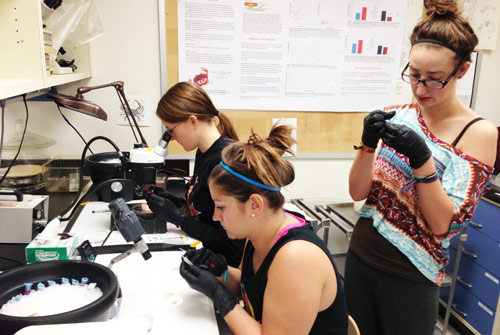Molt-Induced Muscle Atrophy

Skeletal muscle is a remarkably plastic tissue, able to “adapt” to various physiological conditions by changing fiber size and contractile properties. In most animals the tissue constitutes a large energetic investment. Consequently, signaling mechanisms are in place to adjust muscle mass to the activity level and physiological state of the individual. Both myostatin (Mstn) and steroid hormones play important roles. In vertebrates, Mstn, a member of the TGFbeta superfamily, is a negative regulator of muscle size in embryos and adults. Binding of Mstn to activin-like membrane receptors results in phosphorylation and nuclear translocation of Smad transcription factors, which regulate gene expression via transcriptional activation or repression. Glucocorticoids stimulate protein degradation and increase Mstn transcription. These data suggest that Mstn/Smad signaling is a primary target of steroid action in skeletal muscle.
Molt-induced claw muscle atrophy is under the control of steroid molting hormones (ecdysteroids). The reduction of as much as 78% of the muscle mass, which facilitates withdrawal of the claws at molt (ecdysis), is achieved by the degradation of myofibrillar proteins by calpains (CalpB, CalpM, and CalpT). Both Mstn and R-Smad are expressed in claw muscles, and ecdysteroid specifically increases the expression of Mstn, ecdysone receptor (EcR), and CalpT in claw muscle. These data suggest that Mstn is an essential link between ecdysteroid and calpain activation. The specific aims are to (1) determine the regulation of Mstn/Smad signaling by ecdysteroid in land crab and (2) determine the interaction of fiber type and ecdysteroid on claw muscle atrophy in lobster. The experiments integrate molecular, proteomic, and immunocytochemical approaches. Aim #1 quantifies the effects of molting and/or elevated ecdysteroid on the expression of Mstn and R-Smad, as well as the subsequent phosphorylation and nuclear translocation of R-Smad. Aim #2 quantifies the effects of ecdysteroid on both transcriptional and posttranscriptional regulation of Mstn and R-Smad in the three fiber phenotypes (fast, slow-twitch or S1, and slow-tonic or S2). The experiments on land crab take advantage of our ability to manipulate the molt cycle and to culture claw muscle in vitro. The experiments on lobster take advantage of our ability to quantify mRNAs and proteins in muscles that differ in fiber type composition in the dimorphic claws. An advantage of both species is that only the claw muscles are responsive to the atrophy-inducing signal. Muscles that do not respond to ecdysteroid (thoracic muscle in land crab and abdominal muscles in lobster) serve as internal controls, as they are exposed to the same hormonal environment.
The discovery of Mstn and R-Smad in crustacean muscles suggests that regulation of mass is highly conserved between vertebrates and invertebrates. It constitutes an entirely novel and exciting area of investigation. As crustacean muscles have few satellite cells, they constitute an ideal model to determine the direct effects of Mstn on differentiated fibers in adults and therefore can provide insights into Mstn action in humans. Understanding the signaling pathway(s) regulating skeletal muscle mass could have significant impacts on crustacean aquaculture; blocking Mstn signaling could enhance growth and improve product quality.
Research
- Background
- Molting Gland Transcriptome Project
- Molt-induced Muscle Atrophy
- Hormonal Control of Molting
